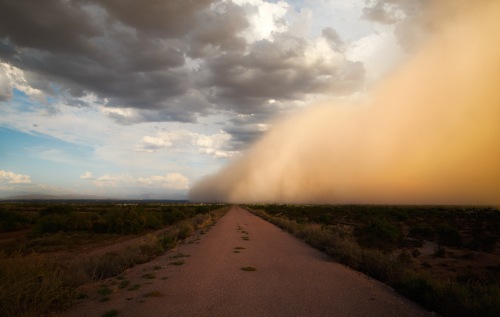Does a dust storm affect my indoor air or harm my air conditioning system?
 When the wind and rain kick up the desert dust, some of it will inevitably land inside your house.
When the wind and rain kick up the desert dust, some of it will inevitably land inside your house.
If your air-conditioning filter is doing its job, it will catch that dust before it finds its way into your duct work or onto the air conditioner’s coils. That way, the a/c won’t blow the dust back into your house.
That’s great, but it can create a different problem for the a/c system. If too much dust hits the filter, it can clog it, which prevents air from filtering through. The a/c needs air to operate. Without it, the system will work harder and harder, but will cool your home less and less.
So tend to the dust that’s trapped in your home’s air conditioning system. Dust that blew into homes—even “tight” homes—can damage the air conditioning system and cause problems if the homeowner doesn’t clean it out. Here is a five-step dust-storm cleanup plan, courtesy of REEis, which specializes in home-performance audits:
1. Rinse your air conditioner’s exterior condenser coil. The condenser transfers the heat it absorbs from the indoor air to the outside of the home via a refrigerant. A coil of piping transfers the heat, via convection, to a metal surface, where the air travels. The more surface area for the heat to transfer across, the better the system can remove the heat from the refrigerant and cool the air. When dust coats the outdoor parts of the condenser, the refrigerant in the system will not remove as much heat, and the a/c will run inefficiently. 
The fix: Turn off the electricity to the outdoor unit by removing the “quick disconnect.” Then thoroughly hose down the condenser.
2. Change your filters. Manufacturers advise changing your air conditioner’s filter once every three months, but that’s not enough in Arizona, even when we have a normal amount of dust. Change your filter now, and then change it again every two weeks until the end of monsoon season. Then, change it once a month until the end of air conditioning season.
Your filter traps dust and other dirty air particles so they won’t travel into your ductwork and blow back into your house. But if your filter is clogged with too much dust, even air can’t pass through. Without a steady flow of clean, filtered air, your a/c will rely on the air it can get through leaks in your ductwork—which usually comes from your hot, dirty attic. #AirFilters
3. Seal your ductwork. When monsoon or dust storms blow through the Valley, dust enters the attics of you home through its attic vents. That dust can get into the living space of your home through leaks between the house and the attic or through leaks in the air conditioning system’s ductwork.
Your best bet: Hire a licensed HVAC professional to seal your ducts, which could leak at the joints. A pro will make sure the seals do not create static pressure problems that can damage your air conditioner.
4. Get an a/c tech in, pronto! Just like the exterior condenser coil, the evaporator coil inside the air conditioner cools the air by absorbing the heat from the interior air. When dust coats the evaporator coil, the air it exhausts into the home will be too warm.
Sealing your ductwork will help. But if you didn’t have a pre-season HVAC tune-up, now’s the time to get one. Don’t wait until next spring to find out that dust has damaged your equipment.
5. Drain your clogged condensate lines. Part of the job of an air conditioner is to remove moisture from the air—and there’s plenty of moisture in the air during the late summer. That moisture exits your house through condensation lines. If dust is clogging the condensation lines, your a/c has to work twice as hard to remove humidity from the air. Plus, you risk drywall and water damage.
#AirFilters
###
